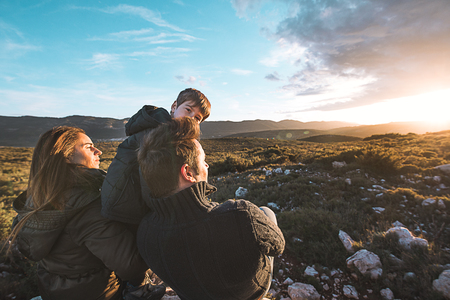1. Why Start a Family Hiking Tradition?
Starting a family hiking tradition is more than just getting outside—it’s about creating lasting memories, encouraging a healthy lifestyle, and enjoying the great outdoors together. In the U.S., hiking is a favorite way for families to bond, unplug from technology, and explore some of the country’s most beautiful parks and trails. Let’s dive into why hiking as a family is such a rewarding tradition.
Building Lifelong Memories
Family hikes are packed with moments you’ll remember for years to come—whether it’s spotting wildlife, reaching your first summit, or sharing stories around a picnic lunch. Each trail becomes part of your family’s story, and these shared adventures often become cherished traditions passed down through generations.
Fostering Healthy Habits
Hiking encourages everyone—kids and adults alike—to stay active. It helps build strength, balance, and endurance, all while having fun. Getting regular exercise as a family sets a strong example for children and helps establish routines that can last a lifetime. Plus, hiking is an activity that grows with your family: you can start with easy nature walks when the kids are young and work up to more challenging trails as they grow.
Benefits of Family Hiking
| Benefit | Description |
|---|---|
| Lifelong Memories | Create special moments and inside jokes unique to your family’s adventures |
| Healthy Habits | Encourage regular physical activity and outdoor time together |
| Connection with Nature | Help everyone appreciate local wildlife, plants, and landscapes |
| Quality Time Together | Unplug from screens and daily routines to focus on each other |
| Problem-Solving Skills | Work together to overcome trail challenges and learn resilience |
Connecting with Nature Together
The U.S. is home to some incredible natural spaces—from national parks like Yellowstone and Yosemite to local state parks and neighborhood trails. When you hike together as a family, you get to experience these places firsthand. Kids learn about the environment in a hands-on way, adults rediscover their sense of wonder, and everyone develops a greater respect for nature. Sharing these experiences deepens your family bonds while helping everyone feel more connected to the world around them.
2. Choosing the Right Trails for All Ages
Finding Family-Friendly Trails Across the U.S.
Picking the right trail can make or break your family hiking experience. The United States is full of trails perfect for all ages and abilities, from toddlers taking their first steps outdoors to grandparents who want a gentle stroll. Here’s how to find accessible, family-friendly trails that everyone will enjoy.
What Makes a Trail Family-Friendly?
- Length: Shorter loops (1-3 miles) are great for young kids or first-timers.
- Difficulty: Look for “easy” or “moderate” ratings, minimal elevation gain, and well-maintained paths.
- Scenic Appeal: Kids love hikes with waterfalls, lakes, wildlife, or interesting rocks and trees.
- Amenities: Trails with restrooms, picnic areas, and parking close to the trailhead make outings smoother for families.
Trail Recommendations by Region
| Region | Popular Family Trails | Main Features |
|---|---|---|
| West Coast | Muir Woods (CA), Multnomah Falls (OR) | Paved paths, giant redwoods, stunning waterfalls |
| Mountain States | Bear Lake Loop (CO), Jenny Lake (WY) | Lakeside views, wildflowers, easy loops |
| Midwest | Starved Rock State Park (IL), Turkey Run (IN) | Canyons, boardwalks, shaded forests |
| Northeast | Kancamagus Highway Trails (NH), Minnewaska State Park (NY) | Scenic overlooks, swimming spots, gentle grades |
| Southeast | Great Smoky Mountains National Park (TN/NC), Congaree Boardwalk (SC) | Accessible boardwalks, river views, wildlife sightings |
Tips for Picking the Perfect Trail
- Use apps like AllTrails or REI Hiking Project to filter by distance and difficulty.
- Check recent reviews for current trail conditions—muddy paths or closures can affect your plans.
- If you have little ones in strollers or wheelchairs, search for “accessible” or “paved” trails.
- Ask local ranger stations or visitor centers for recommendations—they know which trails are best for families each season.
- Look for nature centers or educational signs along the route to keep kids engaged and learning as they hike.
Your Next Step: Involve Everyone in the Planning!
Let each family member help pick a trail or destination. When kids feel included in the decision-making process, they’re more likely to get excited about hiking together! Remember: The goal is not just reaching the end of the trail—it’s enjoying the journey as a family.
![]()
3. Essential Planning and Packing Tips
Getting your family ready for a hiking adventure is all about preparation and packing smart. Here’s how to make sure everyone is comfortable, safe, and ready for fun on the trails.
How to Dress for the Season
| Season | What to Wear |
|---|---|
| Spring | Light layers, waterproof jacket, hat for sun/rain, sturdy sneakers or hiking boots |
| Summer | Moisture-wicking shirts, shorts or lightweight pants, wide-brim hat, sunglasses, sunscreen |
| Fall | Long sleeves, fleece or light sweater, beanie or cap, weather-resistant outerwear |
| Winter | Thermal base layers, insulated jacket, gloves, warm hat, wool socks, waterproof boots |
Must-Have Hiking Gear Checklist
- Backpack: Choose a comfortable daypack with enough space for snacks, water, and essentials.
- Water Bottles or Hydration Packs: Bring plenty of water—at least one liter per person for short hikes.
- Snacks: Pack easy-to-carry foods like trail mix, granola bars, fruit slices, or string cheese.
- First Aid Kit: Include band-aids, antiseptic wipes, tweezers, allergy meds, and any personal medications.
- Sunscreen & Bug Spray: Protect skin from sunburn and pesky insects.
- Navigational Tools: Download trail maps on your phone or bring a printed map and compass—don’t rely solely on cell service!
- Weather Protection: Rain ponchos or jackets just in case the weather changes unexpectedly.
- Tissues/Wipes & Trash Bag: For quick clean-ups and leaving no trace behind.
- Emergency Whistle/Flashlight: Safety items that are helpful even on short trails.
- Cameras or Phones: Capture those special moments together!
Packing Tips for Families with Kids
- Let kids carry their own small backpack with a snack and water bottle—it makes them feel involved.
- Pace yourselves: Choose shorter trails at first and take frequent breaks for exploring or snacking.
- Add a favorite toy or comfort item if your child needs reassurance outdoors.
- If hiking with toddlers or babies, consider a child carrier backpack for safety and comfort.
Extra Advice for a Smooth Day on the Trail
- Check the Weather: Always look at the forecast before you go. Cancel if thunderstorms or extreme conditions are expected.
- Leave No Trace: Teach your kids to respect nature by carrying out everything you bring in—including trash and leftover food.
- Create a Pre-Hike Routine: Review safety rules (like staying together) before every hike so everyone is clear on expectations.
- Praise & Encourage: Celebrate little accomplishments along the way—this helps build confidence and excitement for future adventures!
A little planning goes a long way toward making your family’s hiking tradition safe and enjoyable. With the right gear and preparation, you’re set for an unforgettable time outdoors together!
4. Keeping Kids Engaged on the Trail
Turn Every Hike into an Adventure
When you’re starting a family hiking tradition, keeping kids excited is key. Children are naturally curious and love exploring, but long trails can sometimes lead to boredom. With a little creativity and some classic American outdoor fun, you can make every hike memorable for your whole crew.
Games for the Trail
Simple games help the miles fly by. Try these favorites:
| Game | How to Play |
|---|---|
| I Spy | Take turns spotting something interesting along the trail (“I spy with my little eye, something green!”) and have others guess what it is. |
| Scavenger Hunt | Make a list before you go—pinecones, wildflowers, animal tracks—and see who can find them all first. |
| Trail Bingo | Create bingo cards with things like squirrels, butterflies, or a red leaf. Mark off each one as you spot them. |
| 20 Questions: Nature Edition | Think of an animal or plant you might see on the hike, and let others ask yes/no questions to figure it out. |
Fun Challenges
Add friendly competition or set mini-goals to keep everyone motivated:
- Mile Marker Races: See who can reach the next trail sign first (always keep safety in mind).
- Balance Beam: Challenge kids to walk along fallen logs or rocks where safe.
- Puddle Jumping: After rain, who can make the biggest splash?
- Photo Contest: Give each child a disposable camera or phone to snap their favorite nature shot.
Learning Along the Way
The great outdoors is America’s biggest classroom! Inspire curiosity with educational activities:
- Leaf & Rock Identification: Bring a simple field guide and let kids match leaves or stones to pictures.
- An Animal Journal: Have children draw or write about any wildlife they see—birds, bugs, deer prints, and more.
- Telling American Legends: Share stories about Native American folklore or famous explorers like Lewis and Clark while walking.
- Naming Mountains & Rivers: Encourage kids to learn the names of local peaks or streams and find them on a map together at home.
Pro Tip: Pack Snacks & Surprises
A few treats—like trail mix with M&Ms or surprise stickers—can work wonders when energy dips.
Your Family, Your Tradition
No two families are alike. Mix and match these ideas to fit your group’s ages and interests. With a bit of planning and an open mind, you’ll create hiking memories that last a lifetime!
5. Making Hiking a Lasting Family Tradition
Schedule Regular Hikes: Building Consistency
One of the best ways to make hiking a family tradition is to put it on the calendar just like birthdays or holidays. Pick a day that works for everyone—maybe the first Saturday of each month, or every other Sunday afternoon. If your kids have busy schedules, start with shorter hikes or nature walks close to home. Consistency helps everyone look forward to this special family time.
Sample Family Hiking Schedule
| Month | Trail / Park | Distance | Special Activity |
|---|---|---|---|
| January | Local City Park Trail | 1 mile | Hot Cocoa Picnic |
| April | State Forest Loop | 3 miles | Wildflower Hunt |
| July | Lakeside Pathway | 2 miles | Pond Skipping Stones Contest |
| October | Mountain Lookout Trail | 4 miles | Leaf Collecting & Crafting |
Document Your Adventures: Creating Memories Together
Telling stories and sharing memories helps keep your hiking tradition alive from year to year. Bring along a family adventure journal to jot down what you see, hear, and discover on the trail. Take plenty of photos and let everyone in the family take turns being the “official photographer” for the day. You can even create a scrapbook or a digital photo album to look back on together during family gatherings.
Fun Ways to Document Your Hikes
- Adventure Journal: Write about weather, wildlife, and funny moments.
- Photo Album: Print photos and add captions or drawings.
- Trail Map Wall: Hang up maps of trails you’ve explored and mark your favorites.
- Family Blog or Social Media Page: Share your adventures with friends and relatives across the country.
Pass Down Your Love for the Outdoors: Inspiring Future Generations
The real magic happens when your children grow up loving hiking as much as you do—and maybe even bring their own kids along one day. Make hiking fun by mixing in games like scavenger hunts or letting kids pick out snacks for the trip. Teach them basic outdoor skills such as reading trail signs, packing a backpack, or identifying local plants and animals. Invite grandparents, cousins, or neighbors once in a while—the more, the merrier!
Tips for Inspiring Lifelong Outdoor Enthusiasm:
- Celebrate Milestones: Give small rewards for reaching new trail distances or visiting new parks.
- Create Traditions: Start an annual “family hike day” with matching T-shirts or a special meal afterward.
- Share Stories: Talk about your favorite childhood outdoor memories around the campfire or dinner table.
- Encourage Exploration: Let kids help choose new trails or plan parts of future hikes.
The key is to keep things simple, consistent, and fun—so your family’s love of hiking grows stronger every year.


